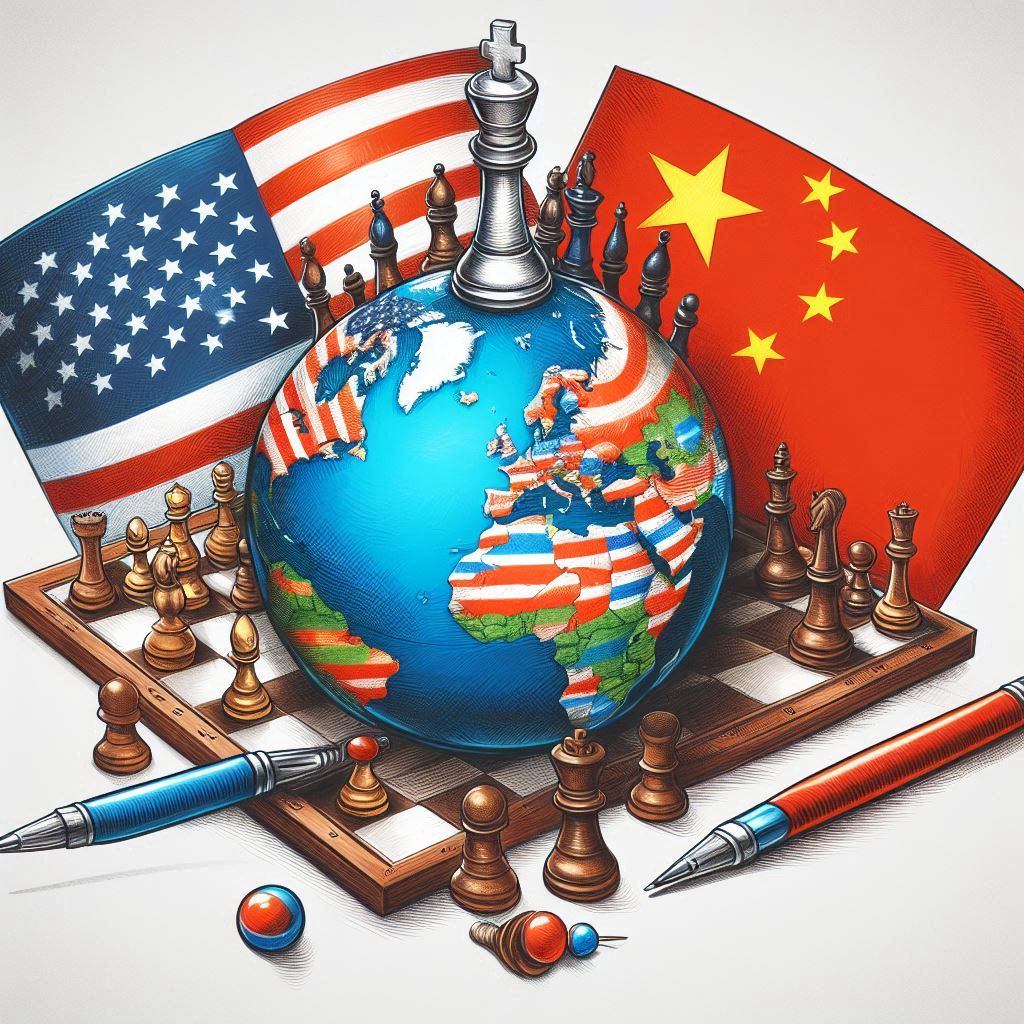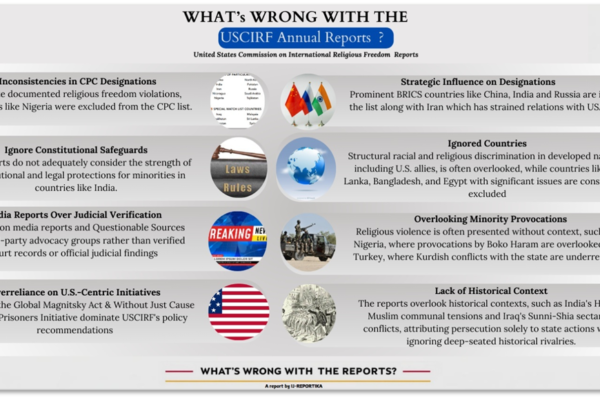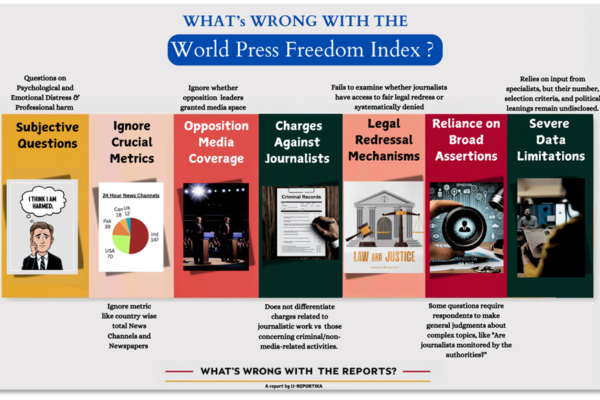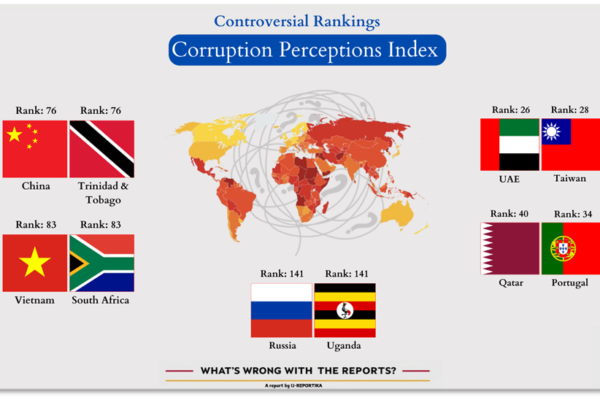
Category: Russia

What’s Wrong with the USCIRF Report
Discover the hidden flaws in the USCIRF Annual Report, including strategic biases, methodological gaps, and lack of transparency, which challenge its credibility and impartiality on international religious freedom.

What’s Wrong with the Global Hunger Index
“The Global Hunger Index serves as a critical benchmark for global food security, but this investigative report by IJ-Reportika uncovers its methodological flaws. From outdated data to inconsistent scoring, these issues misrepresent nations’ progress and obscure systemic challenges, calling for urgent reforms to ensure accuracy and accountability.”

What’s Wrong With the World Press Freedom Index
The World Press Freedom Index aims to measure media freedom worldwide, but its reliance on subjective surveys and perceptions often oversimplifies the nuanced realities journalists face. This article delves into its methodological flaws and the need for a more data-driven, context-sensitive approach.

What’s Wrong With the Corruption Perceptions Index
Discover the critical flaws in the Corruption Perceptions Index by Transparency International. Learn about its biases, subjective methodology, and the challenges in accurately measuring global corruption levels.

INTERVIEW: An Ex-FBI agent helps unravel the mysteries of a spy swap
A secret deal between the US and China announced in November allowed Chinese nationals to be freed in exchange for the release of several Americans imprisoned in China. One of the Chinese nationals who was freed, Xu Yanjun, had been serving a 20-year sentence. He had worked for China’s Ministry of State Security. One of the Americans in China, John Leung, reportedly an FBI informant, had been held in prison for three years. Two other Americans, Kai Li, also accused of providing information to the F.B.I., and Mark Swidan, a Texas businessman, were freed at the same time. In addition, Ayshem Mamut, the mother of human-rights activist Nury Turkel, and the two other Uyghurs were allowed to leave China. They all traveled on the same plane to the United States. Holden Triplett, the co-founder of a risk-management consultancy, Trenchcoat Advisors, has served as the head of the FBI office in Beijing and as director of counterintelligence at the National Security Council. Here, he weighs in on the high-stakes game of exchanging spies. This interview has been edited for length and clarity. Interviewer: Spy swaps have a long history. What was it like in the past? Holden Triplett: During the Cold War, there were a lot of spy swaps. It’s kind of a normal way of interacting between two rival powers. But it was always Russia, or the Soviet Union, and the United States. It’s not something that China had typically engaged in in the past. Interviewer: Why would China, or any country, be interested in a spy swap? Holden Triplett: China would be very interested in getting back the individuals who’d worked for them. The longer they’re in prison in the U.S., the more chance they’re going to divulge information about what they’ve done. Also, the Chinese want to be able to say to the people who work for them, ‘Hey, we may put you in dangerous situations. But, don’t worry, if anything happens, we’ll get you back home.’ The down side for the Chinese, of course, is that it’s an implicit acknowledgement of what they’ve been doing. In the past, they’ve denied that they’re [engaged in espionage]. Interviewer: And for the U.S? Holden Triplett: The idea is the same; We get our spies back. It’s more of a game, I guess you could say. There’s a bit more protection for spies than for others. They get arrested, but they don’t serve time. And so, spying on each other is made into a regularized affair. My concern is that the Chinese say, ‘Now that we’ve established this kind of exchange, people for people, now all we need to know to do now is pick up some more Americans and arrest them.’ Then, the Chinese can try and bargain with the U.S. for their release. We’ve already seen that in Russia with Brittney Griner [an American basketball player who was imprisoned in Russia]. Look at who the Russians got back – Viktor Bout [a Russian arms dealer found guilty of conspiring to kill Americans]. The Russians have wanted him for decades. Nothing against Ms. Griner, but that is a pretty easy decision-making process. They pick up somebody who has star power, and they can get someone they want back. If China’s gotten that message, then Americans should be concerned about going to China. They could become a chip in a larger geopolitical game. There’s a possibility that they could get arrested and end up in a nightmare jail. Interviewer: Well, they say you’re not supposed to negotiate with – Holden Triplett: – with terrorists. Look, I think the U.S. is in a really difficult place. There’s pressure on the U.S. government from the families to get them back. Interviewer: Several Uyghurs were also released. What is the significance of that? Holden Triplett: I would assume the Chinese got something for this. They’re very transactional. They’re not doing something for the good of the relationship between the U.S. and China. Interviewer: It didn’t seem as though John Leung, who’d been held in a Chinese prisoner, was an important asset for the FBI. What do you think was behind this? Holden Triplett: I don’t know what role he played for the FBI, or even if that’s true. But regardless, the message from the bureau is: Don’t worry. Even if you’re doing dangerous work, we will protect you. We will come and get you. We are : Investigative Journalism Reportika Investigative ReportsDaily ReportsInterviews Surveys Reportika
Kim Jong Un wants North Korea to mass produce suicide drones
North Korean leader Kim Jong Un wants the country to begin mass production of suicide drones, raising concerns that Pyongyang could potentially send these to Russia for use in its war in Ukraine. State media reported that the country’s supreme leader Kim Jong Un visited a test site for the unmanned attack aircraft. “The suicide attack drones, designed to be used within different striking ranges on the ground and the sea, are to perform a precision attack mission against any enemy targets,” the Korea Central News Agency report said. In tests, the drones “precisely hit” targets, it said. Kim “underscored the need to build a serial production system as early as possible and go into full-scale mass production,” the report said. Though the report made no mention of the possibility of North Korea manufacturing drones to be sold to Russia, several analysts said that North Korea might look to do just that. The war is the motivation behind North Korean drone development, Bruce Bennett, a researcher at the U.S.-based RAND Corporation told RFA Korean. “Putin wants cheap weapons, and Kim Jong Un can produce them,” said Bennett. “I suspect that Russia transferred drone technology to support North Korea’s production.” North Korean leader Kim Jong Un watches a drone test at the Drone Institute of the Academy of Defense Sciences, Aug. 24, 2024. He also noted that any North Korean ability to mass-produce drones could be a potential threat to South Korea. The successful test of suicide drones as reported by North Korean state media is a concern in light of the deepening ties between Moscow and Pyongyang, Bruce Klingner of the Washington-based Heritage Foundation said. Klingner said that North Korea has already provided Russia with artillery shells, ballistic missiles, and over 10,000 troops. He also said that the recent ratification of a comprehensive bilateral security treaty between Russia and North Korea suggests that Moscow might soon increase transfer of military technology to Pyongyang. Meanwhile, the U.S. State Department expressed concern over the deepening relationship, calling it and its associated weapons transfers “a trend that should be of great concern to anyone who is interested in maintaining peace and stability on the Korean Peninsula, preserving the global nonproliferation regime, and supporting the Ukrainian people.” Edited by Eugene Whong and Malcolm Foster. We are : Investigative Journalism Reportika Investigative Reports Daily Reports Interviews Surveys Reportika
Myanmar junta bombs insurgent-held gem-mining hub killing 9
Read RFA coverage of this topic in Burmese. Junta forces bombed a famous ruby-mining town under insurgent control in central Myanmar killing nine people and wounding 13 in a deliberate attack on civilians, an insurgent group official told Radio Free Asia on Tuesday. Junta aircraft bombed three neighborhoods in Mogok on Monday at around 11 p.m. while one of the military’s Russian helicopters also fired into the town for about 30 minutes, they said. “Nine people died. We have to say it really impacted them badly. The junta wasn’t fighting, they were targeting residents,” said Lway Yay Oo, a spokesperson for the anti-junta Ta’ang National Liberation Army, or TNLA. The insurgent group is part of a three-member alliance that has made striking gains over the past year in northeast Myanmar against forces of the junta that seized power in 2021. The TNLA has been in control of Mogok, in the Mandalay region, since July. Six men and three women were killed in the air raid, said Lway Yay Oo, adding that a child was among the 13 people being treated for their wounds. Radio Free Asia could not independently verify details of the attack and calls to Mandalay’s junta spokesperson, Thein Htay, went unanswered. TNLA fighters were combing through the rubble of 10 homes that were destroyed in the airstrike, said one resident of the town that has been famed for hundreds of years for its rubies and other gem stones. “They shot directly into residential neighborhoods so everyone is afraid,” said the resident. The Myanmar military has been pushed back in different regions of the country over the past year and has increasingly been resorting to airstrikes, on both insurgent positions and civilian areas, human rights groups say. Between January and October, junta airstrikes killed 540 civilians, according to the advocacy group the Assistance Association for Political Prisoners. RELATED STORIES Rebels capture 9 posts in Myanmar’s Mandalay region, open front Myanmar ethnic alliance says offensive will continue until junta overthrown Perhaps it would be better if Myanmar’s civil war became a ‘forgotten conflict’ Translated by Kiana Duncan. Edited by RFA staff. We are : Investigative Journalism Reportika Investigative Reports Daily Reports Interviews Surveys Reportika
Exclusive: How Chinese nationalism is sending jitters through the Arctic
This story was reported with the Norwegian Broadcasting Corporation. Read their story here On an early morning in late July, a luxury expedition cruise ship, boasting the latest in high-end Arctic travel, made a slow approach to the docks of Ny-Ålesund, a remote settlement in Norway’s Svalbard Islands. At 79 degrees north latitude, Ny-Ålesund is the northernmost inhabited outpost on Earth. Isolated in the Arctic’s desolate winter, it hosts just 30 year-round residents. Newayer, a Chinese travel agency, chartered the vessel for 183 tourists from Hong Kong, Shanghai, and Beijing. Each passenger paid at least $13,000 for a two-week “Three Arctic Islands” tour, marketed as an exclusive opportunity to reach the “top of the Earth,” complete with “the luxury of Chinese hospitality.” Clad in matching red jackets bearing a polar bear logo, the travelers disembarked at their first stop: China’s Yellow River Research Station in Ny-Ålesund. There they marked the 20th anniversary of the station – one of several research facilities established on Svalbard by different nations. More than 100 Chinese tourists waved national flags beneath a Chinese Communist Party-style banner hung on the research station’s door. The travel agency’s blog likened the celebration to “raising the Chinese national flag during the Olympics.” Among the participants, a woman in a People’s Liberation Army, or PLA, uniform was seen saluting and posing for photos. A PLA Ground Force patch is visible on her right arm, two professional cameras are slung over her shoulders. “The big picture of China’s ambitions in the Arctic is that it reflects a clear, long-term strategic goal: China wants to be a significant presence in the Arctic,” says Isaac Kardon, a senior fellow for China Studies at the Carnegie Endowment for International Peace, a Washington D.C. think tank. Since declaring itself a “near-Arctic state” in 2018—despite lacking territorial claims—China has steadily built its presence through legal, military, commercial, and individual channels. Svalbard has become the latest frontline. An Arctic Battleground for Great Powers A remote Norwegian archipelago roughly twice the size of Hawaii, Svalbard lies less than 1,000 kilometers from the North Pole, some 650 kilometers north of mainland Norway. Chinese tourists celebrate for a drone-style video at China’s Yellow River Research Station in Svalbard, Norway, July 2024 Entering the ‘gray zone’ Fan Li, the CEO of Newayer, the tour agency, told RFA and NRK that their tour group informed the research station of its plans to stage a celebration at Yellow River, and to hang banners and wave Chinese flags outside the station. The station never objected or even raised it as an issue. “The staff at the Yellow River Station came out to engage with us, and everyone was quite happy about that,” Li told RFA and NRK. A video of the tour group’s celebration was posted to Newayer’s social media account. It further features eight guests telling the camera that they are PLA veterans and perform coordinated military salutes to China while a patriotic song plays as a soundtrack. Afterward, passengers gathered to share their stories of service in the PLA. Li said that the presence of veterans on board was merely a “coincidence” and that when Newayer realized the connection, the company organized a ceremony and incorporated the clip into its video. According to Li, all of those featured were retired, as it’s difficult for active military members in China to travel abroad. However, one cruise participant, who identifies herself in the video as Yin Liu, was photographed wearing military garb bearing the insignia of the PLA on Svalbard. On camera, Liu says she enlisted in 1976 and fought in Vietnam in 1984 and gave the name of her unit. Ying Yu Lin, an expert on the PLA at Tamkang University in Taiwan, identified Liu’s fatigues as a “Type 21” training uniform issued by China’s Ministry of Defense in 2023. It is restricted to military personnel and would not be accessible to civilians, Lin said. The “Type 21” uniform can be seen on the Chinese Defense Department website. Members of China’s Arctic expedition team, based at the Yellow River Research Station, take a boat out for sampling on the Austre Lovenbreen glacier in Svalbard, Norway, June 22, 2024. Questions of diplomacy But sources familiar with diplomatic discussions say that Norway is unlikely to take a leading role in pushing back against China. “Like many countries, Norway just doesn’t have a lot of equities in its dealings with China,” says Kardon. Overt criticism or perceived slights can cause notable damage, like in 2010, when Beijing banned imports of Norwegian salmon after its Nobel committee awarded the Peace Prize to Chinese dissident Liu Xiaobo. But as long as that’s the case, room for more muscular tactics in the Arctic will grow. Last month as China celebrated the 75th anniversary of the People’s Republic, the Chinese Coast Guard engaged in joint operations with Russian forces in the Arctic. This was preceded in September by a meeting of Russian and Chinese officials in Beijing to discuss economic development and resource extraction in the region, and earlier, a Chinese and Russian meeting in Svalbard to explore opening a joint research center in Pyramiden, a former Soviet mining hub on the islands. “So if you’re looking for a pattern here, I would say this is the latest version of what China and Russia are trying to do—find a way to get to the red line without crossing it,” says Lanteigne, referring to the Yellow River celebration incident. “It is a very subtle signal, one that really demonstrates that China is now starting to deviate more directly from Norway regarding what is and is not proper activity on Svalbard.” Lanteigne views this as a pressing challenge that the Norwegian government must confront head-on. “I think there needs to be the understanding that with the Arctic beginning to militarize as a whole, Svalbard is caught in it, whether it likes it or not.” Edited by Boer Deng We are : Investigative Journalism Reportika Investigative Reports Daily Reports Interviews Surveys Reportika
Malaysia objects to Vietnam’s South China Sea island building: media
Malaysia has protested over Vietnam’s island building in the South China Sea in a rare negative exchange between the neighbors, Reuters news agency cited Malaysian officials as saying. Late last month, Radio Free Asia reported on Vietnam’s development of an airstrip on Barque Canada reef, an artificial island within the Spratly archipelago that Malaysia also claims. The reef’s landfill area is estimated to have expanded to nearly 2.5 square kilometers (617.7 acres) as of October 2024, more than doubling in a year. Two unidentified officials told Reuters that the Malaysian government sent a letter of complaint to Vietnam’s foreign ministry in early October, before RFA’s report, “but has so far received no reply.” Malaysia and Vietnam are among the six parties that hold overlapping claims in the South China Sea and to its numerous islands and reefs, alongside China, Brunei, the Philippines and Taiwan. The Philippines has said it was “monitoring” Vietnam’s island-building activities but has not officially protested. The recently leaked letter of complaint, if true, could be a rare point of tension as until now Malaysia has only complained about Vietnamese fishermen’s “illegal activities” in Malaysian waters. Kuala Lumpur claims at least 12 features in the Spratlys, including Vietnam-controlled Amboyna Cay and Barque Canada reef, and Philippines-controlled Commodore and Rizal reefs. Malaysia has a physical presence on five features – Swallow, Ardasier, Erica, Mariveles and Investigator reefs – which are also claimed by some other parties. Due to the complexity of those overlapping claims, regional countries generally stay quiet about their neighbors’ island building and instead focus their attention on China, which has reclaimed the most land in the South China Sea and completed the militarization of three large artificial islands. Suspected Vietnamese runway on Barque Canada reef, Oct. 2, 2024. Anwar visits China Malaysia has repeatedly rejected China’s claims in the South China Sea, most recently in 2023 over the latest edition of the Beijing-issued standard map of China, which encompasses areas lying off the coast of Malaysian Borneo. Prime Minister Anwar Ibrahim has reiterated on many occasions that Malaysia would continue to conduct oil and gas exploration in Malaysia’s exclusive economic zone in the South China Sea, despite objections from China. Anwar is in China on an official visit from Nov. 4-7, his third in two years, and observers say the trip signals a closer relationship between Malaysia and its big neighbor. “That may explain if there is any recent friction between Malaysia and Vietnam, which has had big issues with China in the South China Sea,” said Viet Hoang, a Vietnamese maritime expert. The Chinese government has not said anything publicly about the reclamation works done by Vietnam but Chinese analysts have warned about the risk of a new flashpoint. RELATED STORIES Vietnam expands strategic capabilities in South China Sea Increased risk of conflict in South China Sea, forum warns East Asia fails to adopt South China Sea statement amid finger pointing Malaysia is the rotating chair of the Southeast Asian grouping ASEAN in 2025 and its support would bolster China’s confidence in disputed waters, Viet said. For its part, “Anwar’s government seems to view China as a significant economic opportunity and is willing to set aside other issues to pursue this opportunity,” said Ian Chong, an associate professor of political science at the National University of Singapore. However, if Kuala Lumpur managed to carry on with some oil projects it is mainly thanks to the fact that “they’ve had a longer history of conducting such projects and are physically further away from China,” Chong said. Edited by Mike Firn. We are : Investigative Journalism Reportika Investigative Reports Daily Reports Interviews Surveys Reportika
Cashing In
North Korea is sending more than 10,000 Korean People’s Army troops to fight for Russia in Ukraine, with some 3,000 already moved close to the front in western Russia. The deployment, under a security partnership pact North Korean leader Kim Jong Un and Russia’s Vladimir Putin signed in June, has raised concern among the U.S. and allies South Korea, Japan and Ukraine. Critics see mercenary motives in Pyongyang, which will receive cash and technology for the mission. We are : Investigative Journalism Reportika Investigative Reports Daily Reports Interviews Surveys Reportika

